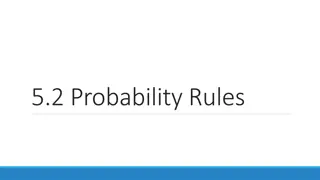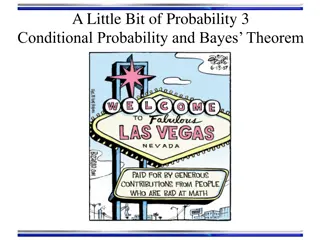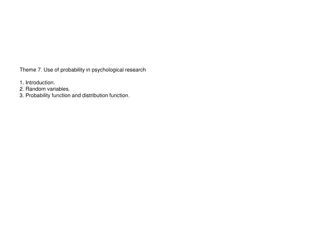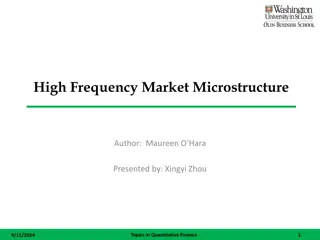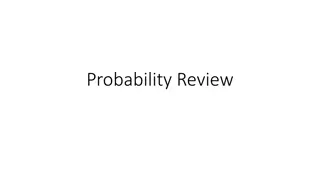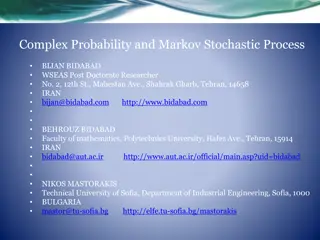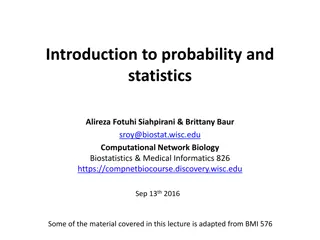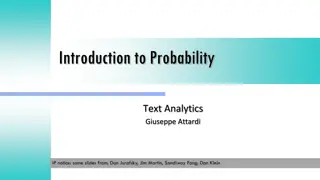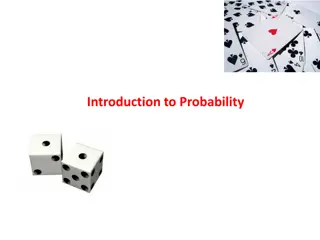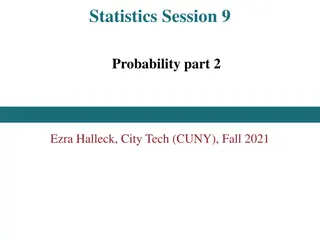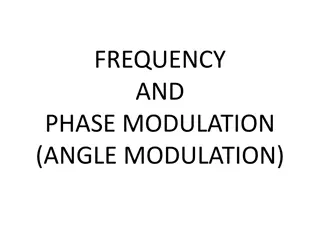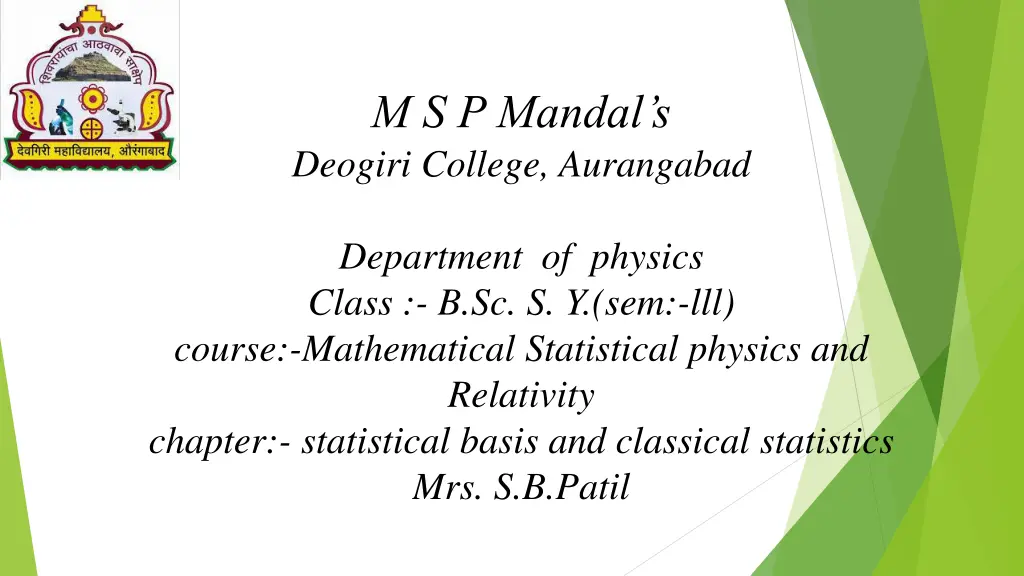
Understanding Principles of Probability in Statistical Physics
Learn about the principle of equal a priori probability, the relationship between probability and frequency, and how to define probability in terms of frequency in the context of mathematical statistical physics and classical statistics at M.S.P. Mandal's Deogiri College. Explore the concept of frequency as a measure of occurrence and how it relates to the classical definitions of probability.
Download Presentation

Please find below an Image/Link to download the presentation.
The content on the website is provided AS IS for your information and personal use only. It may not be sold, licensed, or shared on other websites without obtaining consent from the author. If you encounter any issues during the download, it is possible that the publisher has removed the file from their server.
You are allowed to download the files provided on this website for personal or commercial use, subject to the condition that they are used lawfully. All files are the property of their respective owners.
The content on the website is provided AS IS for your information and personal use only. It may not be sold, licensed, or shared on other websites without obtaining consent from the author.
E N D
Presentation Transcript
M S P Mandals Deogiri College, Aurangabad Department of physics Class :- B.Sc. S. Y.(sem:-lll) course:-Mathematical Statistical physics and Relativity chapter:- statistical basis and classical statistics Mrs. S.B.Patil
Principle of Equal A Priori Probability ; Suppose we toss a coin it is clear in mind that the coin will fall either with its Head up or Tail up. Similarly if a six faced cubical dice is thrown, it is sure that the dice will fall with one of its six faces upward. In the same way If we have an open box divided into two equal sized Compartments X and Y (Fig.), and a small particle is thrown from a large distance in such a way that it must fall in either of the two compartments,
then the probability of the particle to fall in the compartment marked X is equal to the probability that it may fall into the compartment marked Y, Again there is an equal Probability, This principle of assuming equal probability events which are equally likely to occur is known as the principle of equal a priori probability. X Y fig
Probability and Frequency Suppose, the die is asymmetric by adding a little load (by wax) to one of its faces. Now all the outcomes are not equally likely and we cannot say that the probability at appearance of six spots is 1/6. For all such cases, we adopt a technique as under Suppose we toss a coin; say N times and we find that Head appears M times. Here we introduce a term frequency of an event F as F =No of trials in which Head occurs Total number of trials =? ?
Thus, if a coin is tossed 50 time and in 10 of them the coin shows Heads, the frequency of this event is 10/50 = 0.2. From the classical definitions of probability, the probability of occurrence of Head is 0.5 or 50%. Hence, we conclude that frequency is not the same as probability. There must be a relationship between frequency and probability, As the number of trials is increased, the frequency of the event progressively tends to stabilize and gradually approaches a constant value, known as the probability of the event.
We define probability in terms of frequency as P= Nlim M/N Thus in order to obtain sufficiently accurate result ,trials must be conducted until the ratios M/N differ from one another by very small value.
Some Basic Rules of Probability Theory Additive Law of Probability This is applicable to mutually exclusive events. Two or more events are said to be mutually exclusive if the occurrence of any one of them prevents the occurrence of others. Such events never occurs simultaneously. For example, consider two small non-overlapping region V and V in a box of volume V as shown in (Fig.). A particle in V rules out the possibility of its being present, at the same instant in V and vice versa. The two events, thus, are mutually exclusive.
Suppose in N trials the particle is found m times in V and m times in V . The probabilities of finding particles in the two regions are , p =m /N and p =m /N respectively
The number of times that the particle will be found at least one of the two regions in N trials is(m + m ). Hence, the probability will be P ( V or V ) = m + m / N = m /N + m /N = p + p This law can be generalized to any number of mutually exclusive events, giving probabilities say p ,p ,p ..... pn then the probability that any one of them occurs is the sum of the probability of these event P = p +p +p +....+ pn = This is known as additive law of probability i
EXAMPLE A card is drawn from a well shuffled pack of 52 cards. Calculate. the probability for this card to be either a king or a queen. SOLUTION. We are taking out one card out of 52 cards of pack. So the total number ways in Which the event can occur is, N= 52. But we want to draw a specific card i.e. king. There are 4 kings in a pack of cards. Therefore, the number of ways favourable to the first event, m = 4
.. Probability of drawing a king, The number of ways in which second event i.e. drawing a queen may happen, m = 4, as there are four queens too. . . Probability of drawing a queen, p =m /N = 4/52 = 1/13 Both the events are mutually exclusive. Therefore the probability that the card drawn is either a king or a queen is P = p + p = 1/13 + 1/13 = 2/13 p =m /N =4/52 =1/13
Multiplication Rule: Joint Probability In the calculations of probabilities, we sometimes come across random events; such that the probability of occurrence of one does not affect the probability of occurrence of the other. For example in fig. the probability that a molecule A gets into V ,at a particular instant is p = V /V the probability that another molecule gets into volume V at the same instant is p = V /V regardless of whether or not the molecule A gets into V , We want to calculate the probability of joint occurrence of these events, i e., the probability of A getting into V and B getting into V at the same instant.
Suppose in N trials, the molecule A is found m times in V . If p is the probability that B gets into V , irrespective of the presence of A in V ,the number of times the two events will occur simultaneously is m p .Thus, the joint probability of occurrence of these two events, is P = m p /N = m /N x p P = p x p Thus, probability of joint occurence of two independent events is equal to the product of the probabilities of each of these independent events. (p = m /N)
Conditional Probability The probability for an event A to occur the condition that event B has occurred is called the conditional probability and is denoted by P (A/B). This can be better understood by the following numerical Example We throw a die twice and obtain two numbers. What is the probability that these numbers are 6 and 4 precisely in that order?
SOLUTION. The probability that the first throw gives a 6 is 1/6. Similarly, the probability that second throw gives a 4 is also 1/6 these two events are independent. Required probability = 1/6 x1/6 =1/36 Example; - An urn contains 4 black and 3 white balls, What is the probability that on two successive draws, the balls drawn are both black ?
SOLUTION. Suppose the first ball drawn is black. Let the event be called as A. Its probability is P( A) = 4/4+3 = 4/7 This event is followed by second event B in which the second ball drawn is also black (conditional). Since an event A is already realized, the balls remained are 3 black and 3 white out of which the event B is taking place, i.e. second ball out of 6 balls. Hence, the probability of the event B to occur under the condition that A has already realized is P(B/A) = 3/3+3 = 3/6 =1/2 The first event thus has an effect on the probability of the second event. : The probability of the composite event (A + B) is P(A+B) = P(A). P(B/A) = 4/7 x 1/2 =2/7



